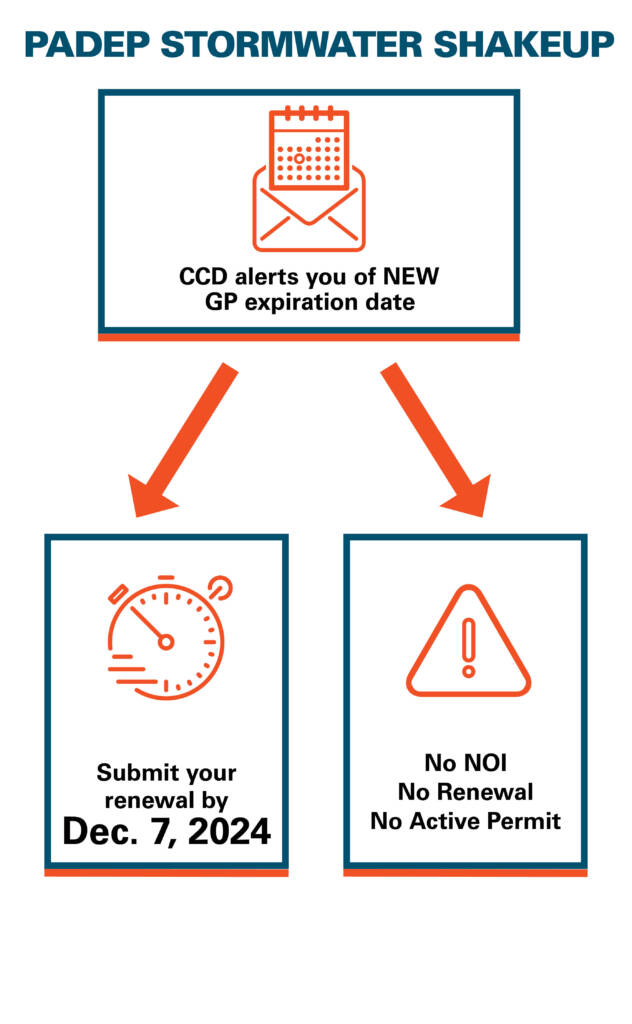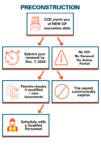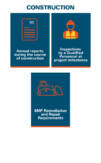On August 30, 2024, the Pennsylvania Department of Environmental Protection (PADEP) announced the new PAG-02 General National Pollutant Discharge Elimination System (NPDES) Construction Stormwater Permit requirements.
Before you dive into this update, make sure to read Part 1 where we outline the general information of the NPDES changes.
Should you find yourself going through the renewal process, it is helpful to keep in mind the goals of an NOI Renewal submission:
- Provide basic existing permit information so the agency can locate your previously submitted documents.
- Describe the status of your project.
- Determine if your project is eligible for the new PAG-02 permit.
- Certify that you will continue to comply with the terms and conditions of the new permit.
Now that you have the baseline, let’s get into the nitty gritty:
1. When is it due?
If you have an active NPDES PAG-02 GP, renewals are required to be submitted BEFORE December 7, 2024. We recommend submitting your NOI Renewal as soon as possible. Do not wait to submit until December as many other organizations will be attempting to push permit renewals through at this time. AKA: The sooner the better!
Some County Conservation Districts request submissions by either email or by paper (USPS) mail. If you are lost on where to find this information, please contact us – we are professional CCD translators.
2. What information needs to be included with the NOI Renewal?
a. NOI Renewal Form
We have the templates / forms for a NOI Renewal that we can populate with your specific project information. In addition, we will analyze your project qualifications and walk you through any additional information that may be required for renewal based on your construction plans.
b. Check(s) for additional fees
3. What happens if my active permit is not eligible for renewal under the new GP requirements?
The fix is easy: Reach out to us to evaluate eligibility. Once we determine your permit is truly ineligible for renewal, we will assist to prepare an Individual NPDES Permit Application. The deadline to submit an individual permit is identical to a renewal: December 7, 2024. While individual permitting regulations are unchanged, it is important to note that there is a little bit more effort involved in those types of permits and the review process takes more time than a GP. If there is doubt in your mind about eligibility, call us ASAP to avoid delays with submitting an individual permit.
4. What is an “amendment” and what needs to be included in the NOI Renewal submission if an amendment is required?
An amendment is a change to previously approved and active NPDES permit. They can be tricky depending on if they are categorized as a major or minor amendment. We can help to determine whether the amendment would be minor or major based on the revisions you intend to make to your plan. Depending on the type of amendment that is required, you may need:
- Completed NOI Form – contact us to make sure you have the right one.
- $500 Administrative Filing Fee
- Any additional CCD-specific review or service fees depending on the district filed
- Disturbed Acreage Fee: $100 x number of newly-added disturbed acres (This only applies for additional acreage)
- If there is a new earth disturbance planned, you may also need to include additional forms, environmental reviews, clearance letters, plan drawings, and supporting calculations.
You must have amendment approval from your local CCD prior to implementation of the plan changes.
5. I am starting a new project, what needs to be included in the NOI submission?
A new Notice of Intent submission has quite an expansive checklist of required documents which are highly technical in nature. There are up to roughly 32 components that may be necessary for a complete, new NOI submission. To name a few:
- Completed NOI Form and associated Module applications
- $500 Administrative Filing Fee
- Any additional CCD-specific review or service fees depending on the district filed
- Disturbed Acreage Fee: $100 x number of disturbed acres
- County & Municipal Notification Forms, Environmental Review & Clearance Letters
- E&S Drawings & Worksheets
- PCSM Drawings & Supporting Calculations
- Wetland determination/delineation report, including mapping (if applicable)
- Sewage planning and Cleanup Release of liability (if applicable)
- Pre-Development Site Characterization with Test pit/boring logs
- Environmental Site Assessments (ESAs)
- Geotechnical Report (Especially for projects in Central and Eastern PA with Karst topography)
- MRC Design Summary Sheets (if applicable)
If this sounds like another language you’re in luck, K&W prepares new NOI applications frequently. We are familiar with the details of the PADEP and Chapter 102 requirements and we are happy to help ensure all of your bases are covered.
6. I feel like I’m drowning in paperwork, what do I do?

Thankfully, you don’t have to do this on your own – we’re skilled professionals and these are all service areas we complete for our clients. You may not understand the difference between one report to another, but we help plan the nuances of land development, landscape design, and earthwork every day for business owners, school districts, higher education facilities and more.
K&W’s civil engineers, surveyors, and stormwater management professional staff are here to make sure you complete your PADEP paperwork properly for submission. Regulations and designations can change as your project unfolds, especially with the updates to consider for the new 2024 PAG-02 General NPDES Construction Stormwater Permit.
Call us today and schedule a time to talk to our civil engineering team to make sure your stormwater control measures during construction and after are properly documented, registered, and ready for the 2024 PAG-02 General Permit requirements.

 we recommend completing the Renewal NOI as soon as possible.
we recommend completing the Renewal NOI as soon as possible.
